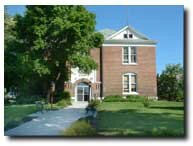|














|
|
County Government
Collaboration
Courthouse
|
-
The 1899 Courthouse is the seat of county government where a County Court form of government---a county judge and two commissioners---serves as the board of commissioners and administers county business. The County Court sets policy, serves on the budget committee, sets county employees' salaries and represents the county at regional and state levels. Members of county boards, committees and commissions are appointed by the County Court. The County Judge has juvenile, probation and probate jurisdiction. Commissioners serve part-time. The Court serves as the board for the unincorporated Biggs Service District.
-
The Budget Committee ---three appointed citizens representative of the county population--- is appointed by the County Court and works with them and the budget officer to develop the county budget.
-
The Board of Property Tax Appeals meets to consider appeals of property tax assessments.
-
The Assessor establishes the value of property in order to determine how much money taxes will provide. The money to operate most county agencies is derived from taxes paid. The Deputy Assessor-Appraiser works with the Assessor.
-
The Clerk and Deputy Clerks issue marriage licenses, supervise elections, keep records of deeds, probate, mortgages and adoptions. This office also handles county payroll and road department accounting. The Clerk serves as Budget Officer and as Clerk of the Board of Equalization, County Court and Probate Court. keep records of deeds, probate, mortgages and adoptions. This office also handles county payroll and road department accounting. The Clerk serves as Budget Officer and as Clerk of the Board of Equalization, County Court and Probate Court.
-
County buildings, grounds and parks, except for the fair grounds, are in the charge of the County Maintenance Director.
-
The Sheriff and Sheriff's Deputies enforce laws, provide corrections facilities, transport prisoners, deliver subpoenas, provide marine patrol during the summer months, coordinate search and rescue operations and work closely with Explorer Scouts. The Sheriff's administrative assistant works in a support capacity. The Sheriff sits on the regional jail operating board for NORCOR and the tri-county 9-1-1 communications board, Tri-Com.
-
The Treasurer is the county banker, receiving and paying out money collected, keeping records of all accounts and audits, and investing money.
-
The Juvenile Director works for the County Judge and works with children with problems, providing juvenile discipline seeking to help youth rather than deliver punishment. Sherman County's Juvenile Director also coordinates the work of the Drug and Alcohol Prevention Coalition and oversees, but is separate from, the Court Appointed Special Advocate (CASA) program for children.
-
The District Attorney is the public prosecutor for the county and provides legal counsel to county officials. The D.A. is assisted by a Clerk, and leads the Pro-Child Team and supervises the Victims' Advocate.
-
The Justice of the Peace has jurisdiction in minor civil and criminal matters, settles disputes, and determines the outcome based on evidence presented.
-
Sherman County's Roadmaster is charged with planning, maintenance and construction of the county roads. He works with road personnel and the Deputy Clerk.
-
The Emergency Services Manager coordinates the recruitment, training, supervision and activities of fire, rescue and ambulance personnel.
-
The County Veterans' Officer is charged with assisting veterans access benefits and services.
-
The Weed Control Officer enforces weed ordinances and laws, and contracts with other agencies to provide weed control.
|
Collaboration: County. Region. State. Nation.
Sherman County's strengths include strong local and regional partnerships and referrals, a comprehensive array of local service providers and strong community engagement and participation.
Sherman County's partnerships with other counties in the region for the purpose of receiving state and federal funding with one administrative office saves money in the delivery of transportation, administrative services, job training, mental health, public health, services to infants, children and families, child care, drug and alcohol prevention, corrections, lobbying, information, emergency, housing and other services.
Sherman County is a member of the Association of Oregon Counties and the National Association of Counties, and works closely with its cities.
Oregon State University Extension Service extends the services of OSU to county residents through home economics, natural resources, leadership, agriculture, community development and 4-H programs in collaboration with citizen advisory groups, 4-H leaders and the County.
The Oregon Judicial Department and regional Circuit Court judges operate the Circuit Court office and courtroom provided by the County, and staffed by the Circuit Court Clerk.
|
Sherman County Courthouse
 Imagine the history of this handsome 1899 courthouse. Imagine the pride, trials, joy, excitement and frustration of the years…of public service, justice, weddings, mortgages, deeds, county business transactions. Imagine the history of this handsome 1899 courthouse. Imagine the pride, trials, joy, excitement and frustration of the years…of public service, justice, weddings, mortgages, deeds, county business transactions.
A BIT CURIOUS! It is a bit curious that, while Sherman County was carved from Wasco County in 1889, the courthouse was not built until ten years later. E.O. McCoy petitioned the legislature for formation of the new county in 1889, proposing to name it Fulton County for Col. James Fulton, a prominent pioneer legislator. In a political move because Col. Fulton opposed a visit to the state house by General William T. Sherman, the new county was named Sherman. Governor Sylvester Pennoyer signed the modified bill on February 25, 1889 and the new county was named for General Sherman.
OFFICIALS. The governor appointed officers to serve the county until the next general election: Col. James Fulton, county judge, [who declined and Owen M. Scott was appointed]; John Medler and Dayton Elliott, commissioners; V.C. Brock, clerk; E.M. Leslie, sheriff; Levi Armsworthy, treasurer; C.C. Meyers, assessor; and C.J. Bright, school superintendent. On March 12, 1889, the newly-appointed officers and constituents met at the Oskaloosa Hotel in Wasco for the official swearing-in. Wasco was declared the temporary county seat. The new officials rented a rock and concrete building in Block 6 on Lot 7 in Wasco to be used by the sheriff and clerk. County and circuit court business was conducted in the school building.
EXPANSION. During the 1891 Oregon legislative session, a bill was introduced to expand the county 18 miles south, taking in Townships 3, 4 and 5 South. This new boundary followed Buck Hollow and an 11-mile east-west boundary across the south.
COUNTY SEAT. Selection of a county seat resumed in earnest. Three towns were selected for the ballot: Wasco, Moro and Kenneth [a hamlet East of DeMoss Springs]. Strong emotions led up to the vote for Moro, influenced by the county’s expansion and new residents. In 1892 the county contracted for construction of a temporary building to house the clerk, sheriff and a vault. Records were moved to Moro. In 1893 a jail was added and the vault was rebuilt. A flag pole and flag were ordered in 1895. In 1896, a deputy clerk and deputy sheriff were hired.
1899. When the county began construction of the new courthouse on Block 23 in 1899, the temporary house on Block 23 in Moro was moved across the street to the south where it remains today. Charles Burggraf of Salem designed the handsome brick structure with Queen Anne architectural features, varied wall surfaces and a corner tower. It was built by contractor, A.F. Peterson, of Corvallis, of thrifty material - brick manufactured in the brick yard behind it. The bell-shaped cupola was originally painted alternating bands of dark and light paint.
FOR THE RECORD. In a 1983 story by Patricia [French] Moore and published in Sherman County: For The Record, it is noted that the Grass Valley Journal reported completion of the new courthouse on November 3rd. On the 10th the Journal editor observed that, “Everyone who has seen the new courthouse wonders how such a house could have been built with so little money [$6,665]. On November 22nd , 1899, Sherman County’s handsome, new courthouse was turned over to county officials.”
PROGRESS. In 1905, the Observer reported that there was a pot-bellied stove in each office and a complex of chimneys in the attic. Will Raymond was commissioned to produce ten large photographs of Sherman County scenes for the county’s exhibit at the Lewis and Clark Exposition in Portland and later for the courthouse walls, where they may be seen today. A jail and related supplies were purchased for $3,847 in 1905 and was located in the room the assessor now occupies. The assessor worked in the front room next to the clerk’s office.
CHANGE. Moore’s story continues, “Major changes took place in 1934…the decision to dig a basement, construct walls, install a furnace and chimney for central heat and to put in a vault…work done as a relief project…under the leadership of county engineer, Hal White.” In 1941, the clerk’s vault was extended and the jail was moved to the rear of the courthouse. The brick on the south wall shows evidence of this move and brick replacement with matching windows. Upstairs remodeling accompanied construction over the jail, with chambers for the judge and jury. The handsome cupola was removed because of wind and storm damage by 1963 when Lee Gunnels painted the courthouse trim.
CHANGE. Modern carpeting, tile ceilings, computers and glass doors join delicate wooden ornamentation, filigree knobs and round-topped windows. The white picket fence is long gone; the jail is a museum artifact. A time capsule was preserved on the grounds during the 1989 county centennial. New sidewalks and landscaping in 1999 marked the 100th anniversary of the county’s seat of government in an ever-changing world.
|
|

![]()